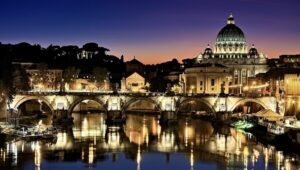
Around the mid-first century of our era the volatile Emperor Nero – for reasons we shall see in due course — resolved to eradicate the new religion from the east which was fast taking root in Rome. Across the next two hundred years many – but not all – of his successors continued the effort with varying degrees of intensity, but, as the historian Tertullian informs us, the blood of the martyrs became the very elixir of life for the infant Church of Rome. As one writer expressed it, “Surely it is not easy to discount a story for which the witnesses are willing to be slain.” Indeed hundreds, maybe thousands, of pagan or agnostic Romans were drawn to the Gospel message by the unforgettable sight of the serenity of the believers as they were being led to slaughter. Today, Christianity marches on in its third millennium. The mighty Roman Empire did not survive a half of one.
Today, all over Rome, signs of Christianity’s ultimate triumph abound. Today, its monuments and shrines rise, literally, over or next to, or even within the ruins and rubble of old Rome and have forever altered the city’s skyline. Where once upon a time the tympanums of temples to Jupiter, Mars, Venus, and other ancient deities were silhouetted against the Italian firmament, one now sees campaniles and cupolas, each surmounted by a cross. And floating high above them all – like a gigantic white hot-air balloon – is the dome of St. Peter’s on the opposite side of the Tiber.
______________________________

The dome of St. Peters figures prominently on the urban landscape of the city of Rome. Emphyrio, Pixabay
______________________________
On the summit of the Capitoline Hill, for example, the fallen stones of the Temple of Juno provide a bedrock foundation for the medieval church of Santa Maria in AraCoeli, whose cascading one hundred and twenty four marble steps were transferred here from the nearby Temple of Apollo.
Far below, in the Great Forum, three temples ultimately were converted into houses of Christian worship. Within the walls and colonnade of the sanctuary to the deified Emperor Antoninous and Empress Faustina the early believers erected a church to San Lorenzo. What was left of the sacred edifice honoring the divinities, Venus and Roma, was incorporated into a church named Santa Francesca Romana. And, lastly, the circular shrine of Romulus, son of the Emperor Maxentius, became the apse of a church honoring Saints Cosmas and Damian.
On the nearby island in the Tiber, from the year 292 B.C.,when Rome was struck by a deadly plague, there stood the Temple of Aesculapius, the Greek god of medicine. In the tenth century, the city’s Christians built on this site a church to the apostle Bartholomew, whose bones are said to repose beneath the main altar. This holy place remains to this day a focal point of pilgrimage.
The Aventine Hill in antiquity was graced by seven majestic temples. On the site of the one named for the goddess Diana, now stands the quaint little church of Santa Prisca. At the highest point of this same hill where there rose in the imperial age a shrine to Bona Dea i.e. the “Good Goddess,” now exists the baroque Piranesi masterpiece of Santa Maria del Priiorato.
Down in the valley along the bank of the Tiber the ancient citizenry put up a beautiful Corinthian–colonnaded round temple to the demi-god Hercules, and a rectangular one to Portunus, god of the harbor. Both date to the second century before Christ and survive in a remarkable state of preservation due to their use as Christian churches throughout the Middle Ages, which resulted in careful, constant maintenance. Just across the cobblestoned street is the romanesque sixth century edifice of Santa Maria in Cosmedin, which stands above an intact small Mithraic temple.
Not far from here, in the Campus Martius district, above the remains of the once splendid Temple of Minerva, the war goddess and protectress of old Rome, we come upon a Gothic structure honoring the Virgin Mary. The church bears the poetic name: Santa Maria Sopra Minerva. (Sopra is Italian for “above.”).
Lest the reader, at this juncture, get the impression that it was only pagan temples that got this Christian makeover, let us here point out the many secular, civic facilities and public grounds that underwent a similar conversion.
For example, the still intact Curia or Senate House – whose walls once rang with fiery orations during tumultuous legislative sessions – was transformed into the church of Saint Adrian of Nicomedia in the year 630. From then on, the old chamber softly echoed the solemn Gregorian Chant of Christian clergy and worshippers. (The building was deconsecrated in the late nineteenth century and reclassified as a historic site.} Even the city’s maximum security jail, the Mamertine Prison, did not escape the Christianization of both Republican and Imperial Rome’s historic sites. Peter and Paul were incarcerated here – by order of Nero – in the Mamertine’s dreaded subterranean dungeon, the Tullianum, to await their execution nine months later. Sometime after the Church’s liberation by Constantine’s Edict of Milan in 313, the local disciples fashioned out of the prison a chapel which still goes by the fitting name, San Pietro in Carcere. (On certain feast days Mass is still celebrated on the marble altar in this notorious old lockup.)
A few blocks away, on the site of the outdoor shopping mecca which the ancients knew as the Forum Holitorium (Produce Market), an influx of sixth century Greek Christian migrants erected the massive church of San Giorgio in Velabro. (Velabrum is the Latin name for this former commercial district.)
______________________________
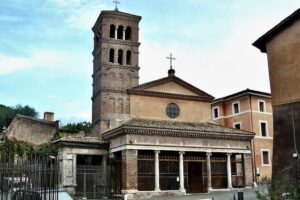
The San Giorgio in Velabro Church. Fallaner, CC BY-SA 4.0, Wikimedia Commons
______________________________
In this same neighborhood today’s visitor – pilgrim or tourist – may also pay a visit to Sant Angelo in Pescheria, where the local fishmongers of a bygone age carried on a bustling business, or to Santa Maria in Via Lata (Saint Mary’s on the Wide Street) which was built on the ruins of the Saepta Julia, a large, porticoed enclave which was used as the main polling precinct for elections by the General Assembly. This public project – conceived by Julius Caesar and completed by his successor Augustus – was designed with many aisles to keep the long lines of voters orderly.
On a part of the remainder of the grandstands of the oval Stadium of Domitian, the Christian flock honored, with a small shrine, the lovely teenaged Agnes who was martyred here. The grand baroque church, which has replaced the original tribute since 1635, is the work of the prolific architect Borromini and is named for the poor innocent: Sant Agnese in Agone. What was left of the emperor’s arena evolved into the ever popular Piazza Navona (“Navona” being a corruption of “in Agone”).
From here a twenty five minute stroll through the heart of Rome will take you to the huge square called Piazza del Popolo where, as you enter from the Via del Corso, you will see identical twin churches: Santa Maria di Monte Santo to your right and Santa Maria dei Miracoli on the left. The latter occupies the site of what remained of the extravagant mausoleum of the dictator Lucius Cornelius Sulla. (Note: Of Rome’s more than four hundred churches, incidentally, some seventy or so are named for the mother of Christ, patroness of the Eternal City.)
The Emperor Hadrian (A.D. 117-138), who was vehemently opposed to the cult but did not hunt down its practitioners, would be aghast if one day he were to return to life only to learn that his proud Pantheon is now the Church of Saint Mary and the Martyrs; that his massive tomb on the left bank of the Tiber has long been used as a papal refuge; that the Pons Aelius, which he built to span the river as an access to his final resting place is now celebrated as The Bridge of the Angels and features at the far end the two most venerated Christian leaders: St. Peter and St. Paul.
_____________________________
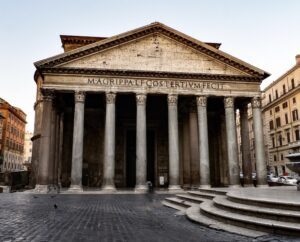
The Pantheon, or the Church of St. Mary and the Martyrs, as it appears today in Rome. Krystianwin, Pixabay
_____________________________
A later ruler, Diocletian (284-305), who launched a bloody persecution resulting in the slaughter of multitudes of the flock of Christ, would be dismayed to find that the tepidarium of his lavish bath complex was transformed into a house of worship, called Santa Maria degli Angeli, by the giant of the Renaissance, Michelangelo. (Because of the great hall’s peculiar dimensions, the moody architect created a transept longer than the nave.) Diocletian’s sprawling spa was surrounded by a rectangle of lofty walls sporting a large round tower at each of the four corners. One of the three towers still extant was destined to become the church of San Bernardo alle Terme (St. Bernard at the Baths).
_____________________________

Santa Maria degli Angeli (Rome) – Facade. NikonZ7II, CC BY-SA 4.0, Wikimedia Commons
_____________________________
Across the length and breadth of Eternal Rome the present-day visitor will see — and hear – yet more evidence of Christianity’s centuries-long architectural response to its early tormentors. Crowning each of the two dozen or so soaring obelisks, brought back from Egypt by the swaggering Roman legions as tall, slender trophies of war, is a cross. The still standing second-century monumental hundred-foot-high bas reliefed column of Trajan, which once supported a marble statue of him on its summit, now holds aloft an effigy of Peter the Apostle. Down the street from here (the Via del Corso) rises a similar column, atop which stood a sculpture of Marcus Aurelius, which has long since given way to one of the Apostle Paul. The iconic Colosseum is marked at the fifty yard line with a huge black cross commemorating the countless Christians said to have been martyred here.
_____________________________

The Column of Trajan (right). AlekseyMyagky, Pixabay
_____________________________
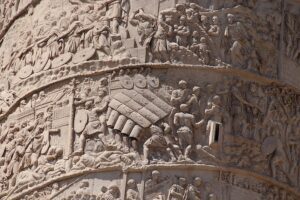
The Column of Trajan still shows the immaculate, detailed bas relief telling stories and events of pagan Rome. Gary Todd, Public Domain, Wikimedia Commons
_____________________________
Four of the ancient eleven waterworks, the amazing aqueducts, having been restored by the Renaissance popes. Each terminate in a spectacular monumental fountain, the marble facade of which bears the name of the pontiff who commissioned the work.
And providing a melodious touch to Christianitiy’s survival, an integral part of the city’s soundtrack, colossal church bells ring out the hours all day long over the rooftops of Rome.
…..
Christian pilgrims to Rome, hoping to be swept back across a million yesterdays to apostolic times, often list a visit to one church in particular as a major priority. More so than St. Peters, this site enables one to tangibly peel away the centuries: The Church of San Clemente. Just a stone’s throw from the Colosseum, it is actually three churches superimposed one upon the other, with massive stonework and piles of masonry from three distinct Roman epochs. On the property, Christians have gathered for worship across two thousand years of Church history. When Peter was serving as bishop of Rome, there dwelled here a pious priest named Clement, who allowed his residence to be used as a clandestine domus ecclesia, i.e. house church.
_____________________________
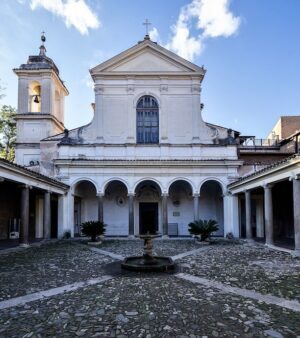
The Basilica of San Clemente. Labicanense, CC BY-SA 4.0, Wikimedia Commons
_____________________________
Everything seems to indicate that Clement belonged to the aristocratic Flavian family, which gave Rome three emperors: Vespasian, Titus, and Domitian. In the year 88 Clement was elected to the Throne of St. Peter, thereby becoming the fourth pope of the infant Church that was at the time struggling to survive the bloodbaths of the persecutions.
Soon after Domitian was elevated to the purple, he brought the full might and fury of Imperial Rome crashing down on the city’s small but growing Christian community. Even family ties counted for naught as he issued the order to have his cousin Pope Clement and the consul Flavius, a recent convert, executed. Sometime in the fourth century after Constantine had put an end to the onslaught against Christianity, the faithful filled the ground floor of Clement’s home with rubble and mortar to provide a solid foundation for the basilica they were soon to raise on that hallowed ground. From early writers, such as St. Jerome, we learn that this basilica was given the Latin name Sanctus Clemens (in Italian – San Clemente as we know it today), in honor of the martyred pontiff.
Throughout the early Middle ages, Saint Clement’s remained one of the most prominent of all the city’s Christian shrines. Then in the year 1084 came the infamous Norman sack of Rome. Beautiful, historic Saint Clemens was severely damaged. In 1108 Pope Paschal II began construction of a new basilica atop the remains of the fourth century structure. The half-hidden older edifice was filled in completely and vanished from human sight for seven hundred and fifty years.
It wasn’t until 1857 that the amazing stratification of the property was discovered. Doing some restoration work under the supervision of the Dominican, Father Mullooly, workmen came upon the church beneath. (Since 1667, San Clemente has been in the care of an order of Irish Dominican priests.) The priest solicited funds from all over the globe to have the lower church completely cleared. These excavations revealed an imposing three-aisled basilica with its graceful apse and canopied altar still intact. Well-preserved, too, were numerous eighth, ninth, and tenth century paintings and mosaics depicting events in the life of Pope St. Clement. Continued digging deeper underground led Father Mulooly into the very rooms of Clement’s home, which in imperial times stood at what was then ground level. Further probing brought yet more antiquity to light. Just across a narrow back alley from this house-church was another pink-brick residence whose owner had carved out a room for purposes of worship in another popular religion of the age – Mithraism.
In the mithraeum one sees a vaulted ceiling, stone benches for the worshippers, and a small altar with fine bas-reliefs showing the Persian deity Mithras sacrificing a bull to the sun-god. (Plutarch tells us that the Mithraic mysteries were first bought to Rome by soldiers of Pompey the Great.)
Having visited the lower basilica, one can readily notice that Pope Paschal was extremely faithful to its architectural plan in his design of the upper church. That plan included a colonnaded courtyard — out front. In this area – called the atrium – there remained, whenever the sacred rites were going on inside, those taking instructions in the faith prior to being baptized, along with those doing penance for various trespasses, and the more curious among non-believers.
The interior of the upper basilica features all the aspects of a typical medieval church, including a mosaic-adoned apse, a marble baldacchino over the main altar, and a marble-enclosed Schola Cantorum or Choir area. There are also two highly ornamental pulpits – one for the reading of the epistle, the other for the gospel. High upon the soaring triumphal archway framing the sanctuary are mosaics of Peter and his third successor, Clement.
Even the very pavement of Saint Clement’s is a masterpiece of art and a perfect example of a cosmatesque marble floor laid out in striking geometric patterns. And so it is then, that in visiting the Basilica of San Clemente on the Via San Giovanni in Rome, one can step out of a twenty-first century vehicle and roll back nine centuries by entering the church built by Paschal; roll back eight more by descending a staircase into the church mentioned by St. Jerome; and yet four more by picking one’s way down another set of stairs into Clement’s house-church of apostolic times – and while down there, stealing a glance into the dark, damp house of worship of a cult that has long since entered oblivion.
____________________________
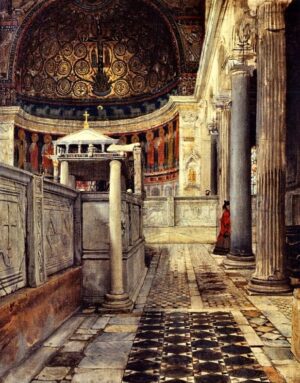
Interior of Basilica of San Clemente al Laterano in Rome (1863), by Lawrence Alma-Tadema. Oil on canvas. Fries Museum, Leeuwarden, Netherlands. Public Domain, Wikimedia Commons
____________________________

The Mithraem. kevingessner, CC BY-SA 4.0, Wikimedia Commons
____________________________
Only in Rome is it possible to enjoy an experience so archaeologically unique.
…..
Now, as for the ruthless Nero, who had sought to crush the Church in its infancy, the irony – or karma if you will – seems never to end. In July of A.D. 64 a suspicious fire broke out in the wooden bleachers of the Circus Maximus and raged out of control into a city-wide conflagration, devastating eleven of the fourteen precincts established by Augustus. The egotistic Nero, long known to be unhappy with his capital and wanting to level it to pave the way for a glittering new city which he would name for himself, Neronia, was widely thought to be responsible for the arson. But he found a convenient scapegoat in the Christian sect, which he quickly subjected to a relentless savage persecution. He also issued an edict forever forbidding the existence of the cult, with the penalty of death for those discovered practicing it. His enormous, state-of-the-art circular meat market on the Coelian Hill – the Macellum Magnum – was to become in the early sixth century the church of San Stefano Rotondo, St. Stephen in the Round. Upon the wreckage of the tyrant’s impressive hippodrome over in the Ager Vaticanus (the Vatican Meadows) stands the greatest church in all Christendom: the Basilica of St. Peter, prince of the apostles and the first Bishop of Rome. Nero’s custom of addressing – or ought we say haranguing – his suffering subjects, from the balcony of his shamefully sumptuous palace, has been replaced by the tradition of the Pope imparting his apostolic blessing – Urbi et Orbi – from the central loggia of his baroque Basilica upon the throngs of pilgrims in the gargantuan square below.
One final irony: Though condemned to death by the Roman Senate, Nero, when he ended his reign of terror via suicide, was nonetheless given a full state funeral. His ashes were entombed at the foot of the Pinciana Hill, in a huge magnificent altar of precious porphyry enclosed by a marble balustrade. Over the ensuing centuries the people of Rome were spooked by a persistent legend maintaining that Nero’s ghost haunted the area. When Paschal II (1099-1118) ascended the Chair of St. Peter one of his first acts was to purge the city of “Nero’s curse” by destroying the shrine and scattering the ashes to the winds. Paschal then soon established on the site a church to the Virgin. In the following century the structure was enlarged with funds from the Romans themselves and renamed Santa Maria del Popolo … Saint Mary of the People.
___________________________

Basilica of Santa Maria del Popolo. Jakub Hałun, CC BY-SA 4.0, Wikimedia Commons
___________________________
Thus it is that for contemporary archeologists hoping to come upon the leftovers of the Rome of the Caesars, they must often search beneath the ubiquitous layers of the Rome of the Popes.
______________________________
Advertisement

EXPLORE THE ANCIENT ETRUSCANS IN PERSON!
Experience a unique, up-close-and-personal hike among ancient hilltop towns in central Italy. You will walk the sensational countryside of the regions of Umbria and Tuscany, soaking in important sites attesting to the advanced Etruscan civilization, forerunners of the ancient Romans; imposing architectural and cultural remains of Medieval Italy; local food and drink; and perhaps best of all — spectacular scenic views! Join us in this collaborative event for the trip of a lifetime!


